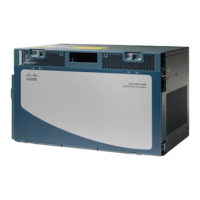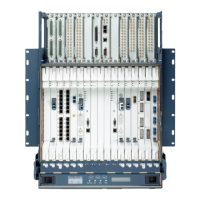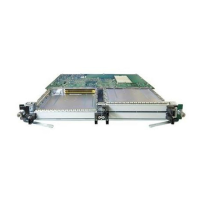8-3
Cisco ONS 15454 SONET/SDH ML-Series Multilayer Ethernet Card Software Feature and Configuration Guide, R4.0
78-15224-02
Chapter 8 Configuring IEEE 802.1Q and Layer 2 Protocol Tunneling
Understanding IEEE 802.1Q Tunneling
Figure 8-2 Normal, IEEE 802.1Q, and 802.1Q Tunneled Ethernet Packet Formats
When the packet enters the trunk port of the service-provider egress switch, the outer tag is again
stripped as the packet is processed internally on the switch. However, the metro tag is not added when it
is sent out the tunnel port on the edge switch into the customer network, and the packet is sent as a normal
IEEE 802.1Q-tagged frame to preserve the original VLAN numbers in the customer network.
In Figure 8-1 on page 8-2, Customer A was assigned VLAN 30, and Customer B was assigned VLAN
40. Packets entering the ML-Series card tunnel ports with IEEE 802.1Q tags are double-tagged when
they enter the service-provider network, with the outer tag containing VLAN ID 30 or 40, appropriately,
and the inner tag containing the original VLAN number, for example, VLAN 100. Even if both
Customers A and B have VLAN 100 in their networks, the traffic remains segregated within the
service-provider network because the outer tag is different. With IEEE 802.1Q tunneling, each customer
controls its own VLAN numbering space, which is independent of the VLAN numbering space used by
other customers and the VLAN numbering space used by the service-provider network.
At the outbound tunnel port, the original VLAN numbers on the customer’s network are recovered. If
the traffic coming from a customer network is not tagged (native VLAN frames), these packets are
bridged or routed as if they were normal packets, and the metro tag is added (as a single-level tag) when
they exit toward the service provider network.
If using the native VLAN (VLAN 1) in the service provider network as a metro tag, it is important that
this tag always be added to the customer traffic, even though the native VLAN ID is not normally added
to transmitted frames. If the VLAN 1 metro tag were not added on frames entering the service provider
network, then the customer VLAN tag would appear to be the metro tag, with disastrous results. The
global configuration command “vlan dot1q tag native” must be used to prevent this by forcing a tag to
be added to VLAN 1. Avoiding the use of VLAN 1 as a metro tag transporting customer traffic is
recommended to reduce the risk of misconfiguration. A best practice is to use VLAN 1 as a private
management VLAN in the service provider network.
The IEEE 802.1Q class of service (COS) priority field on the added metro tag is set to zero by default,
but may be modified by input or output policy maps.
Double-tagged
frame in service
provider
infrastructure
IEE 802.1Q frame from
customer network
Original Ethernet frame
Destination
address
Length/
EtherType
Frame Check
Sequence
Source
address
SADA Len/Etype Data FCS
SADA Len/Etype DataEtype Tag FCS
SADA Len/Etype DataEtype Tag Etype Tag FCS
74072

